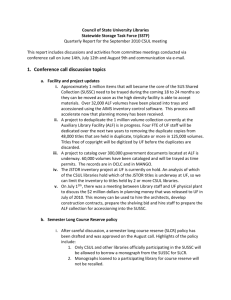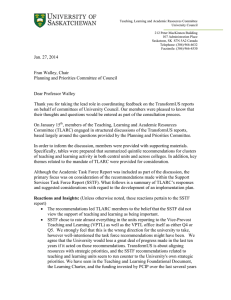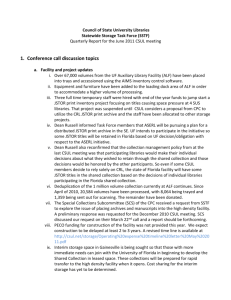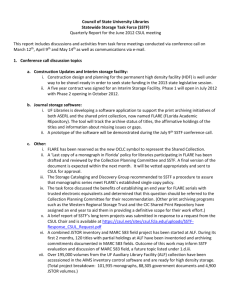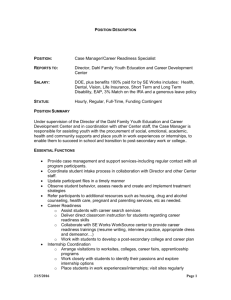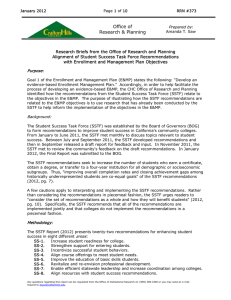Student Success Task Force
advertisement
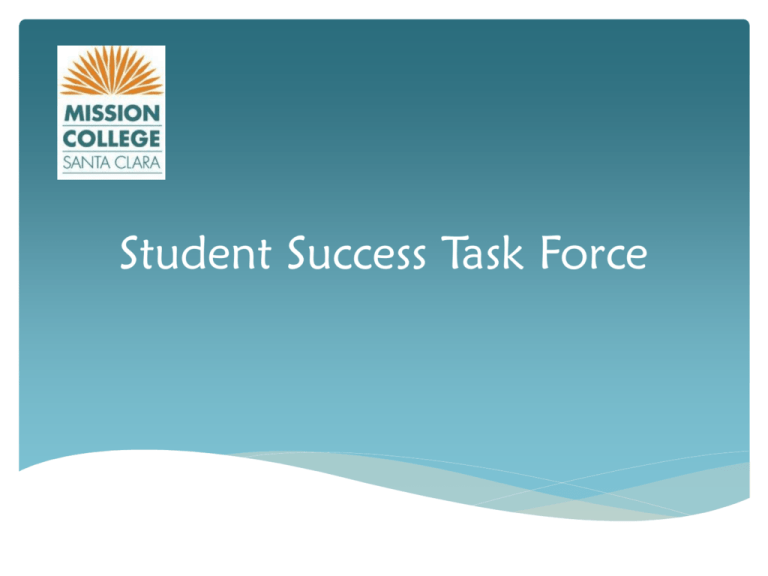
Student Success Task Force SSTF 8 Focus Areas – 22 Recommendations 1. 2. 3. 4. 5. 6. 7. Increase college and career readiness Strengthen support for entering students Incentivize successful student behaviors Align course offerings to meet student needs Improve education of basic skills students Revitalize and re-envision professional development Enable efficient statewide leadership and increase coordination among colleges 8. Align resources with student success recommendations SSTF – Focus Area 1 Increase Student Readiness For College 1.1 Community colleges will collaborate with K-12 education to jointly develop new common standards for college and career readiness that are aligned with high school exit standards. How and why: closely collaborate with the SBE and Superintendent of Public Instruction to define standards for college and career readiness reduce the number of students needing remediation help ensure that students who graduate from high school meeting 12th grade standards are ready for college-level work encourage more students to achieve those standards by clearly defining college and career expectations. SSTF – Focus Area 2 Strengthen Support For Entering Students 2.2 Require all incoming community college students to: (1) participate in diagnostic assessment and orientation and (2) develop an education plan. How and why: students have the foundational tools to make informed choices The Board of Governors will define categories of students who should be exempt from mandatory placement and orientation (students with a prior degree returning to pursue training in a different career field) Colleges would also be able to exempt students from each of these requirements on a case-by-case basis. SSTF – Focus Area 2 Strengthen Support For Entering Students 2.2 Require all incoming community college students to: (1) participate in diagnostic assessment and orientation and (2) develop an education plan. MC COUNSELING: Offering orientation classes at the high school Working with the college to offer early registration for completing orientation Multiple modalities: in-person, hybrid, online, foreign languages Implementing a process for exemptions Utilize report each term to contact students that have not completed orientation Require educational plan in orientation and other study skills courses Required by special programs Grad project eAdvising – in progress as directed by the state SSTF – Focus Area 2 Strengthen Support For Entering Students 2.4 Require students whose diagnostic assessments show a lack of readiness for college to participate in a support resource, such as a student success course, learning community, or other sustained intervention, provided by the college for new students. How and why: A student’s readiness for college is based on several factors in addition to their academic proficiency in English and mathematics numerous models of supporting under-prepared through college success courses, first-year experience programs, learning communities, and campuswide initiatives SSTF – Focus Area 2 Strengthen Support For Entering Students 2.4 Require students whose diagnostic assessments show a lack of readiness for college to participate in a support resource, such as a student success course, learning community, or other sustained intervention, provided by the college for new students. MC COUNSELING: Summer bridge program Referrals to late start Counseling classes Couns 003 + Read 053 Sp13 Couns 005 + Engl 908 F13 SSTF – Focus Area 2 Strengthen Support For Entering Students 2.5 Encourage students to declare a program of study upon admission, intervene if a declaration is not made by the end of their second term, and require declaration by the end their third term in order to maintain enrollment priority. How and why: First-year concentrators were nearly 50 percent more likely to complete than those who entered a program in their second year, Unable to declare a major or program of study by the end of second term, should be provided counseling and career planning interventions Fail to declare a program of study after their third term should lose enrollment priority. SSTF – Focus Area 2 Strengthen Support For Entering Students 2.5 Encourage students to declare a program of study upon admission, intervene if a declaration is not made by the end of their second term, and require declaration by the end their third term in order to maintain enrollment priority. MC COUNSELING: Provide overview of educational options during orientation and other success courses Teach Couns 012 – Careers & Lifestyles 3.0 units & Couns 012A 1.0 unit Utilize online career assessments and resources like Eureka & CA Career Café Discuss educational options during appointments and while drafting ed plans SSTF – Focus Area 3 Incentivize Successful Student Behaviors 3.1 The Community Colleges will adopt system-wide enrollment priorities that: (1) reflect the core mission of transfer, career technical education and basic skills development; (2) encourage students to identify their educational objective and follow a prescribed path most likely to lead to success; (3) ensure access and the opportunity for success for new students; (4) incentivize students to make progress toward their educational goal. How and why: Current law and practice guiding student enrollment tends to favor the continuing student, based solely on their accrual of course units SSTF – Focus Area 3 Incentivize Successful Student Behaviors SSTF – Focus Area 8 Align Resources With Student Success Recommendations 8.2 Invest in a student support initiative. Student Success Act of 2012 (SB 1456) Planning & Implementation Timeline Fiscal Year 2012-2013 System-level Planning Year: • Implementation workgroups convened October 2012 to develop proposals for title 5 Matriculation revisions, new allocation formula, & revised MIS data elements & definitions • New program planning & budget process developed • SB 1456 effective January 1, 2013 Fiscal Year 2013-2014 District/College-Level Planning Year: • Develop program plans • Implement MIS changes & ensure accurate & complete data reporting • Allocations remain consistent as prior year, new formula not applied • Funding targeted to core services of orientation, assessment, counseling & advising, & other education planning services Fiscal Year 2014-2015 District/College-Level Implementation Year 1: • Program plans & budgets submitted • Continue to ensure accurate & complete data reporting • Allocations remain consistent as prior year, new formula not applied • Legislative implementation report due July 1, 2014 (biannually thereafter) Fiscal Year 2015-2016 Implementation Year 2: • FY 15-16 allocations based on 14-15 yearend data reported • Application of funding formula beginning this year Fiscal Year 2016-2017 Implementation Year 3: • FY 15-16 allocations based on 1415 year-end data reported • Legislative report due July 1, 2016
